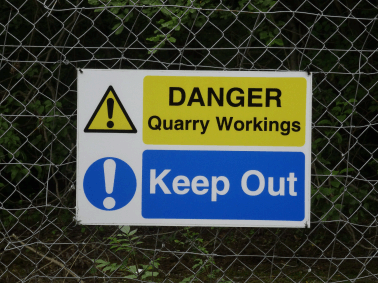Quarries can be dangerous places, at the best of times, and the potential hazards are manifold, even if the site is operational or dis-used. Many of these hazards may exist where rock or aggregate is being extracted by a combination of drilling, boring, blasting or crushing. Some of these hazards for working quarries are outlined below, with links to Label Source products to create awareness of these occupational health and safety dangers.

Breathing hazards can be caused by airborne dust particles, which are a natural consequence of the quarrying process, and these can be combined with inhalation of engine exhaust fumes or fumes from welding can lead to respiratory problems, particularly silicosis (from exposure to silicon particles).
Eye hazards can be caused by contact with dust, stone fragments or from on-site arc welding can damage the retina.
Ionising radiation hazards can occur from naturally released radon gas, and from the use of radioactive substances within instrumentation.
Non-ionising radiation hazards stem from over exposure to the UV in direct sunlight, and from the infrared and ultraviolet effects from arc welding which can affect those welding and others in the proximity.
Hearing hazards from excessive noise levels from plant, equipment, vehicles and blasting can lead to deterioration in hearing to deafness, or the onset of the hearing sensation tinnitus.
Vibration hazards can include HAVS (Hand arm vibration syndrome) from the continual handling of equipment such as road breaking hammer drills, angle grinders, chain saws and disc cutters, resulting in complaints such as finger blanching, pain, and permanent loss of sensation. In addition, whole body vibration symptoms can be caused from operating quarry vehicles and fixed plant, which can cause back and neck pain.
Skin complaints can lead to skin cancer for exposure to excessive ultraviolet light, and dermatitis from contact with oil lubricants, grease, solvents and bitumen.
Manual handling injuries can be caused by operating heavy quarry equipment, the manual shovelling of earth, clay and shales, and the lifting and carrying of heavy stones.
Weather hazards include operating in high or low temperatures, in excessive humidity, heavy rain or snow, and skin exposure to sunlight as covered above.
Other hazards can cover: Injuries from falling rocks; accidents to drivers and pedestrians from vehicle collisions, or overturning vehicles ; confined space incidents; injuries from slips, trips and falls; crush, entrapment, pinch and finger trap, punch or blade injuries can be caused during machine maintenance; explosion and fire hazards from explosives, primers and detonators, from flammable materials such as paint, thinners and cleaning fluids); and COSHH issues from chemical hazards, such as battery and hydrochloric acids etc.).
At the end of quarrying operations, while many of the above cease to be relevant, that does not mean that all safety threats end. Rather the type of risks change. Many result from unauthorised access to the quarry by children, bikers and quadbikers which can lead to safety issues from falling objects, entrapment from digging, falls from climbing, and injuries from slips and falls down steep surfaces or from cliff edges, and overturned vehicles. Flooded quarries can pose dangers from swimming or diving in deep, cold water, with strong under-currents and with the possibility of collisions with underwater obstacles.
Besides the above health and safety products, Label Source has supplied many asset tags for equipment, conveyor belts and rollers, electrical warning labels, maintenance labels and tags, traffic signs, and contaminated land signs. For further information on any of these products, please contact Label Source by e-mail (sales@labelsource.co.uk) or by telephone (0800 3761693 in UK, or + 44 1443 842769 if outside the UK).